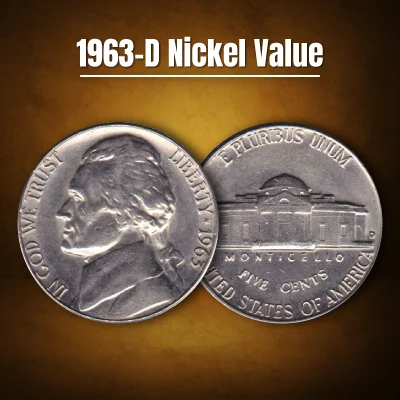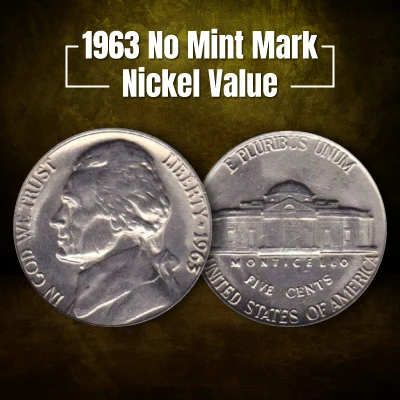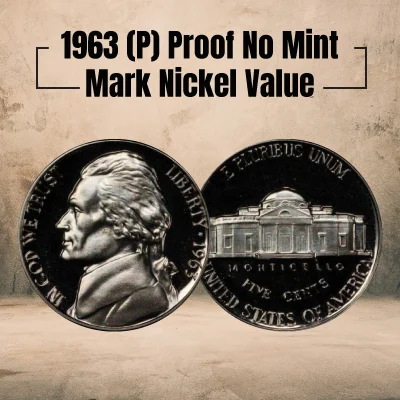
In the numismatics market, certain coins are taken casually by some collectors, but a few are prized by those in the know, such as the Five-Cent Piece. 1963 Nickel value is essential for collectors as it has a great moment of history and unique design.
Following JFK's assassination in late 1963, the Kennedy Half Dollar was first introduced in 1964. This sparked interest in all coins struck around that time, including 1963 Nickels, in the past. The 5c piece proved copper coins were practical, changing minting methods and base metal acceptance. So, let's find out more about the 1963 Nickel value and history making it more than a pocket change.
As previously noted in our other articles, Philadelphia and Denver were the only mints to produce 1963 nickels; both mints produced business strikes, but Philadelphia produced the proof pieces. These coins, which are meant for everyday use, are often referred to as circulation strikes or regular strikes. (In contrast to collector-focused proofs, mint sets, satins, and other special strikes.)
Coins are classed as proof-like (PL) or deep mirror proof-like (DMPL), incidentally. These are standard circulation dies and blank coins, but they have a unique sheen that could lead one to believe they are proofs. In a similar vein, business strikes rated between 50 and 58 are known as uncirculated coins. These coins are removed from the press and sold before they become tarnished from use.

The Denver Mint produced 276,829,460 nickels bearing the D Mint Mark in 1963. A 2019 MS 66+ sold for $1,320 on December 7. As of August 2023, PCGS has seen seven of these, making them valued at $1,650. However, on June 26, 2008, a Full Step (i.e., you can plainly see five or six of the Monticello stairs) graded MS 65 cost $9,200. Currently, it is $5,250 because PCGS possesses six of them.
| Attribute | Details |
|---|---|
| Mint Mark | D |
| Place of Minting | Denver |
| Year of Minting | 1963 |
| Face Value | $0.05 |
| Production | 276,829,460 nickels |
| MS 66+ Value (2019) | $1,320 |
| Current Value (August 2023) | $1,650 |
| MS 65 Full Step Value | $5,250 |
| MS 65 Full Step Value (June 2008) | $9,200 |
| Current Value (August 2023) | $5,250 |

In 1963, 175,784,000 Business Strike Nickels were produced by the Philadelphia Mint. There were no mint marks on them. A 2019 MS 67+ sold for $3,408 on March 21st.
Since there are only two known, they will cost $3,500 in August 2023. In 2020, however, an MS 67 FS cost $3,600. Eight have been sent to PCGS for grading; therefore, in August 2023, 1963 nickel value with no mint mark will be $4,750. However, an MS 66+ FS costs $1,400.
| Attribute | Details |
|---|---|
| Mint Mark | None |
| Place of Minting | Philadelphia |
| Year of Minting | 1963 |
| Face Value | $0.05 |
| Production | 175,784,000 Business Strike Nickels |
| MS 67+ Value (March 21, 2019) | $3,408 |
| Current Value (August 2023) | $3,500 |
| MS 67 FS Value (2020) | $3,600 |
| Current Value (August 2023) | $4,750 |
| MS 66+ FS Value | $1,400 |

A proof coin typically includes a frosted design and a field that resembles a mirror. Pre-treating the die and the coin blank, also known as a planchet, produces these effects. The blank is thrown into a drum filled with 6 mm stainless steel balls, which cause it to tumble and shine brilliantly. We refer to this procedure as burnishing. Next, horsehair brushes are used to rescrub the die's shiny areas.
The frosted pieces are either digitally laser-textured or pickled in acid in the meantime. The hazy effect on older acid coins diminishes gradually each time the die strikes a blank, resulting in the initial 50 to 100 coins having a Deep Cameo—a sharp contrast between the field and the device. The following hundred are cameos. The Philadelphia Mint produced 3,075,645 Proof Nickels in 1963.
In April 2012, a PR 70 was $978, and in August 2023, it was $600. After grading more than 200 samples, PCGS forecasts that a PR 66 CAM, which sold for $190 on eBay in July 2019, will only be worth $20 in August 2023. PR 69 CAM is the highest known grade; its projected 2023 value is $65. And the current value of a PR 69 DCAM, which was $881 in July 2013, is $475. But $15,000. For a PR 70 DCAM.
| Attribute | Details |
|---|---|
| Mint Mark | None (Proof) |
| Place of Minting | Philadelphia |
| Year of Minting | 1963 |
| Face Value | $0.05 |
| Production | 3,075,645 Proof Nickels |
| PR 70 Value (April 2012) | $978 |
| Current Value (August 2023) | $600 |
| PR 66 CAM Value (July 2019) | $190 |
| Current Value (August 2023) | $20 |
| PR 69 CAM Value | $65 |
| PR 69 DCAM Value (July 2013) | $475 |
| Current Value (August 2023) | $15,000 |
A 1963 nickel value can increase from hundreds to thousands of dollars due to mint errors. These could be die errors, like hub doubling or repunched mint markings. Alternatively, there may be process errors, such as misalignment, double denominations, double strikes, or incorrect planchets. Let's examine various 1963 Nickel Errors' prices.
When the die shifts between hub strikes, it is known as hub doubling or, in this instance, hub tripling. This causes the second or third imprint to fall at an angle that is marginally different from the first strike, typically to the right or left. The die then duplicates the mistake on every coin it produces. An MS 64 TDR mistake sold for $277 in October 2014. An MS 64 is valued at $165, and an MS 65 at $300 in August 2023.
| Error Type | Description | Value |
|---|---|---|
| Tripled Die Reverse | Die shift causing multiple imprints | $165 (MS 64) |
| $300 (MS 65) | ||
| Previous Value (October 2014) | $277 |
Hub doubling is sometimes referred to as double die reverse or obverse, depending on which side the error happened, as we have just explained. Additionally, it becomes a variation because, before it is discovered and corrected, the defective die may produce hundreds or even thousands of coins. The words or the portrait's eyes and ears are the easiest spots to spot doubling. This coin was worth $40 in PF 66.
| Error Type | Description | Value |
|---|---|---|
| Doubled Die Reverse | Hub doubling causing doubled features | $40 (PF 66) |
To make the design more clear, the average coin is struck at least twice. However, if it strikes something as it is leaving the press, you could end up with overlapping photos. Additionally, the coin's shape may occasionally get distorted. This is the case in this instance, and the Trust is facing the incorrect direction because the second stroke was ¾ off-center. Valued at almost $100, this mint mistake was graded MS 63.
| Error Type | Description | Value |
|---|---|---|
| Double Struck 75% Off-Center | Coin struck off-center, resulting in overlapping images | $100 (MS 63) |
You might be tempted to polish and clean an antique coin that you uncover. However, as cleaned coins are only given the grades of Authentic, Genuine, or Details, this reduces their value. Even if there is a significant inaccuracy in the coin, this causes the price to plummet significantly. A portion of the surface of this double-struck, off-center nickel was unmarked. The MS 60 only cost $115, even with its striking mint error.
| Error Type | Description | Value |
|---|---|---|
| Double Struck and Cleaned | Coin cleaned post-strike, reducing value | $115 (MS 60) |
Nickels contained 10% copper and 90% silver in 1963. Because of this, they were substantially smaller than nickels, which were devoid of silver. Therefore, the defect and melt value of a nickel struck on a blank meant for a 10c made it highly expensive. Additionally, some words were cut out because of the smaller diameter, making the coin much lighter—2.6 g—than before. The error in MS 62 was $550.
| Error Type | Description | Value |
|---|---|---|
| Struck on a Dime Planchet | Nickel struck on a dime-sized blank | $550 (MS 62) |
This is yet another incorrect planchet. However, the nickel was struck on a 1c planchet this time. Because it is the copper tint of a penny rather than the silver color of a nickel, it is easily distinguished. Because pennies have a diameter of 19.05 mm as opposed to a nickel's 21.21 mm, some of the writing was removed, resulting in a lighter coin. $300 bought an MS 63 RB. It costs $380 for an MS 60.
| Error Type | Description | Value |
|---|---|---|
| Struck on a Penny Planchet | Nickel struck on a penny-sized blank | $300 (MS 63 RB) |
| $380 (MS 60) |
Re-punched mint mark, or RPM, was discussed in the section's introduction. It occurs when an employee sways when applying the mint mark, causing the second impression to land in a slightly different location and leaving remnants of the first mint mark visible beneath. Usually, the final detail to be placed on the die, the mint mark (RPM) in MS 65, is valued at approximately $175.
| Error Type | Description | Value |
|---|---|---|
| RPM (Re-punched Mint Mark) | Second mint mark impression slightly offset | $175 (MS 65) |
Errors involving hub doubling are frequently found 30 days after the coin is released. The FS number (which should not be confused with the FS grade for Full Step coins) will be used to confirm and document these First Strike faults. However, mechanical doubling, or a double striking on the mint date, is more likely to be the cause of a spread that is discovered later. About $10 in AU 50 and $50 in MS 65 is its value.
| Error Type | Description | Value |
|---|---|---|
| Spread on 6 Obverse | Spread due to mechanical doubling on the mint date | $10 (AU 50) |
| $50 (MS 65) |
Errors that occur when something gets in the way of the blank or strikes through are known as strike-through errors. It can be a sliver of cloth, a piece of metal, or some tape. Usually, the object will leave evidence of its existence, like a shadow or a stencil, on the finished coin. However, the coin is worth more if the object itself survives. The retained staple, in this case, rated AU 50, is valued at $550.
| Error Type | Description | Value |
|---|---|---|
| Struck Thru Retained Staple | Error caused by a staple striking through the coin | $550 (AU 50) |
In summary, the 1963 Nickel holds a special place in the hearts of collectors, not just for its historical context but also for its rarity and unique errors. While these nickels may not contain silver, 1963 nickel value lies in their condition, mint marks, and any errors they might carry.
Whether you're a seasoned collector or just starting out, the 1963 Nickel offers a fascinating glimpse into U.S. coinage and the stories that surround it. Keep an eye out for those rare mint mistakes—they might just turn a simple nickel into a valuable treasure!
No. The nickel has been a cupronickel coin for its entire existence, which is how it received its moniker. The 5c was referred to as a Half Dime or Half Disme with a silent "s" when it was a silver piece. It was never referred to as a nickel until the 1866 version was designed. Nevertheless, the War Nickel was momentarily changed to 35% silver, 56% copper, and 9% manganese since nickel was required for military hardware and weaponry throughout the conflict. These coins, which bore large mint markings above the dome of Monticello, were produced between 1942 and 1945. Prior to 1982, they were the only Philadelphia coins to bear mint marks. The coin was withdrawn from circulation after the war because of its large mint mark, which made it readily identifiable.
Such events also influenced 1963 Nickel Value in the long run.